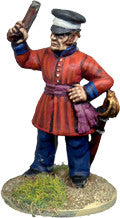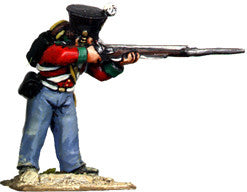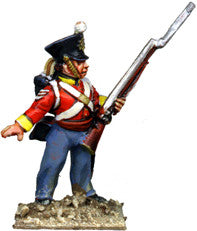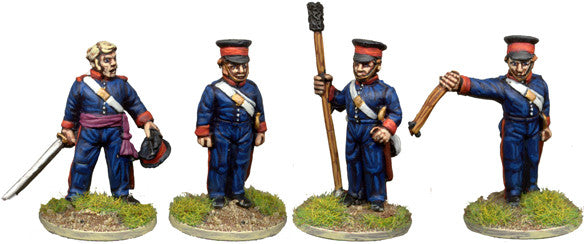1st China War (1st Opium War) 1839-42 and the Battle of Chapu
by John French
 This was essentially a trade war. The Chinese wanted to keep foreign influence to a minimum and restrict trading to the area around Canton. The Portuguese had trading facilities at Macau not far away. The Hon. East India Co. (HEIC) had become the most powerful trading company in the area buying silk, tea and porcelain and paying in gold. In 18th Century opium was on general sale for medicinal purposes, but the Chinese Emperor/Government became alarmed at the increasing misuse and spread of it. The Emperor decided to ban its import except under licence from the Government. At first the HEIC complied with this as they wished to protect their normal trade. Addicts as a result turned to smugglers, particularly in Macau. The HEIC meanwhile had seen a decline in their once profitable trade in Bengal owing to greed and corruption. Trade was such that the company were in financial difficulties by the late 1760s and they needed to look elsewhere to earn revenue. They turned to the sale of opium to recoup losses. Opium was already grown in Bengal and the HEIC had a monopoly over the area, following Clive’s victory at Plassey in 1757. The HEIC could now control prices and supply of opium, and in China’s 300 million population they saw a ready market. HEIC could flaunt the laws restricting the importation by selling to dealers in Macau. They sold to Hong Kong merchants, who in turn sold to Canton licensees. The HEIC used their own shipping even, but they claimed that blame could be laid on them as they had no direct link with Canton and the sale of opium. The representatives of HEIC would then use the money to buy legitimate trade goods. (It sounds like the original Chinese laundry).
This was essentially a trade war. The Chinese wanted to keep foreign influence to a minimum and restrict trading to the area around Canton. The Portuguese had trading facilities at Macau not far away. The Hon. East India Co. (HEIC) had become the most powerful trading company in the area buying silk, tea and porcelain and paying in gold. In 18th Century opium was on general sale for medicinal purposes, but the Chinese Emperor/Government became alarmed at the increasing misuse and spread of it. The Emperor decided to ban its import except under licence from the Government. At first the HEIC complied with this as they wished to protect their normal trade. Addicts as a result turned to smugglers, particularly in Macau. The HEIC meanwhile had seen a decline in their once profitable trade in Bengal owing to greed and corruption. Trade was such that the company were in financial difficulties by the late 1760s and they needed to look elsewhere to earn revenue. They turned to the sale of opium to recoup losses. Opium was already grown in Bengal and the HEIC had a monopoly over the area, following Clive’s victory at Plassey in 1757. The HEIC could now control prices and supply of opium, and in China’s 300 million population they saw a ready market. HEIC could flaunt the laws restricting the importation by selling to dealers in Macau. They sold to Hong Kong merchants, who in turn sold to Canton licensees. The HEIC used their own shipping even, but they claimed that blame could be laid on them as they had no direct link with Canton and the sale of opium. The representatives of HEIC would then use the money to buy legitimate trade goods. (It sounds like the original Chinese laundry).
 The British government also benefited from the arrangement as the tea was sold back in Britain and the British earned substantial revenue from the hefty import duties. In the 1790s it is estimated that around 25% of tax revenues came from tea. The British government were anxious to increase their revenues from the HEIC extended trade. The HEIC increased opium production and even became more directly involved in smuggling via corrupt Chinese officials. The British Government wanted a general extension of trade to other areas of China, but diplomatic attempts at this failed. The HEIC needed an extension to survive. The Emperor next tried to ban opium trade altogether, but too many corrupt officials made this impossible. He then appointed an Imperial Commissioner for Canton who was given authority to deal harshly with traders and smugglers. He also demanded that the British hand over the 20,000 chests of opium they had in store. At first the British thought this was an attempt at extortion until they were reminded that whilst in China they were subject to Chinese law which included the death penalty. The HEIC and British government were alarmed at this and eventually Palmerston’s Govt. agreed to send an expedition to China which included ships of the line and 7,000 troops. The excuse used was that British lives and property had been threatened and that Govt. officials had been rebuffed.
The British government also benefited from the arrangement as the tea was sold back in Britain and the British earned substantial revenue from the hefty import duties. In the 1790s it is estimated that around 25% of tax revenues came from tea. The British government were anxious to increase their revenues from the HEIC extended trade. The HEIC increased opium production and even became more directly involved in smuggling via corrupt Chinese officials. The British Government wanted a general extension of trade to other areas of China, but diplomatic attempts at this failed. The HEIC needed an extension to survive. The Emperor next tried to ban opium trade altogether, but too many corrupt officials made this impossible. He then appointed an Imperial Commissioner for Canton who was given authority to deal harshly with traders and smugglers. He also demanded that the British hand over the 20,000 chests of opium they had in store. At first the British thought this was an attempt at extortion until they were reminded that whilst in China they were subject to Chinese law which included the death penalty. The HEIC and British government were alarmed at this and eventually Palmerston’s Govt. agreed to send an expedition to China which included ships of the line and 7,000 troops. The excuse used was that British lives and property had been threatened and that Govt. officials had been rebuffed.
Compensation was demanded along with extended trading rights to the ports of Amoy, Fuchow, Ningpo and Shanghai.
Battle of Chapu (Chapo) 18 May 1842
 Sir Hugh Gough was at the head of 2,200 troops sent to capture the coastal town of Chapu which was held by 8,000 Chinese regulars, including many tartars. The Chinese were prepared to receive a frontal attack. The British contented themselves with the Royal Naval ships shelling the fortifications by way of a diversion, whilst Gough landed his troops on the left flank, some 4 miles away. They were divided into three columns. The defences extended some 3 or 4 miles, there was a canal which ran almost around the walls and there were batteries located in the suburbs. Several heights protecting the harbour had breastworks and batteries mounted upon them. To the northwest of the city was a large camp (like military cantonments in India, but with superior houses) which belonged to the Tartars.
Sir Hugh Gough was at the head of 2,200 troops sent to capture the coastal town of Chapu which was held by 8,000 Chinese regulars, including many tartars. The Chinese were prepared to receive a frontal attack. The British contented themselves with the Royal Naval ships shelling the fortifications by way of a diversion, whilst Gough landed his troops on the left flank, some 4 miles away. They were divided into three columns. The defences extended some 3 or 4 miles, there was a canal which ran almost around the walls and there were batteries located in the suburbs. Several heights protecting the harbour had breastworks and batteries mounted upon them. To the northwest of the city was a large camp (like military cantonments in India, but with superior houses) which belonged to the Tartars.
 The left column was given orders to move around the base of the heights to cut off the Chinese there from any communication with the city. The right column was directed to assault the heights and capture the batteries & fortified buildings. The remaining column was to act as support to the other two. The Chinese were forced to retreat from one height to another, although offering resistance they were overcome by superior firepower. The Chinese firearms were mostly matchlocks. One building was stubbornly defended by some 300 Tartars and only taken when powder bags were used to force an entry where only 50 or so wounded defenders remained. The bridge over the canal which led to the east gate of the city had been destroyed, but engineers managed to find 3 boats which were used to ferry troops across the unfordable canal. The grenadiers of the 55th and a party of Sappers & Miners used scaling ladders and the walls were taken. The walls had few guns or jingalls mounted on them according to Gough. Other troops including an extra party of sailors and marines secured other city gates and the city was captured. The arsenal, foundry and gunpowder factory were destroyed before the expedition sailed on. British casualties 60, Chinese around 1,200.
The left column was given orders to move around the base of the heights to cut off the Chinese there from any communication with the city. The right column was directed to assault the heights and capture the batteries & fortified buildings. The remaining column was to act as support to the other two. The Chinese were forced to retreat from one height to another, although offering resistance they were overcome by superior firepower. The Chinese firearms were mostly matchlocks. One building was stubbornly defended by some 300 Tartars and only taken when powder bags were used to force an entry where only 50 or so wounded defenders remained. The bridge over the canal which led to the east gate of the city had been destroyed, but engineers managed to find 3 boats which were used to ferry troops across the unfordable canal. The grenadiers of the 55th and a party of Sappers & Miners used scaling ladders and the walls were taken. The walls had few guns or jingalls mounted on them according to Gough. Other troops including an extra party of sailors and marines secured other city gates and the city was captured. The arsenal, foundry and gunpowder factory were destroyed before the expedition sailed on. British casualties 60, Chinese around 1,200.
British troops:
Right Column (Lt.Col. Morris) - H.M.18th (492); H.M.49th (451); Madras Sappers & Miners (26) - total 48 officers, 921 other ranks.
Centre Column (Lt.Col. Montgomerie) - Royal Artillery (27); Madras Artillery (172); Madras Sapper & Miners (176); 36th Madras N.I. (Rifle Co.) (103) - total 15 officers, 363 other ranks.
Left Column (Col. Schoedde) - H.M. 26th (548); H.M. 55th (289); Madras Sappers & Miners (26) - total 43 officers, 820 other ranks.
Chinese:
Estimated at 8,000 of which 1,700 were Tartars
 .
.
Suggested reading:
Holt, Edgar - ‘The Opium Wars in China’ (Putnam. London. 1964). Covers period 1839-60.
Waley, Arthur - ‘The Opium War Through Chinese Eyes’ (Geo. Allen & Unwin. London. 1958).

Click here for a guide to British Uniforms of the 1st China War by John French
